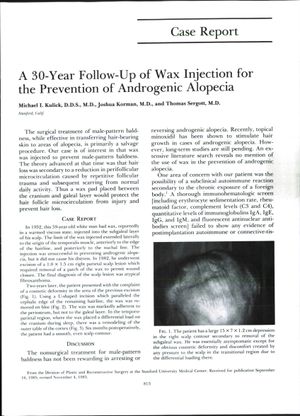A 30-Year Follow-Up of Wax Injection for the Prevention of Androgenic Alopecia
December 1986
in “
Plastic and Reconstructive Surgery
”

TLDR Wax injection did not stop hair loss and caused changes to the skull.
In 1952, a 59-year-old man received an injection of wax into the subgaleal layer of his scalp with the intention of preventing male-pattern baldness, based on the theory that hair loss was due to reduced microcirculation from follicular trauma. The treatment was unsuccessful in preventing androgenic alopecia. Thirty years later, the patient required removal of a portion of the wax due to a scalp lesion diagnosed as atypical fibroxanthoma. Subsequent removal of more wax revealed it was adherent to the periosteum and had caused remodeling of the skull's outer table. No evidence of autoimmune disease was found in the patient, despite the chronic presence of the wax, a foreign body. The study concludes that wax injection did not prevent hair loss and resulted in cranial remodeling. No other cases of wax injection for androgenic alopecia were found in the literature, and the nonsurgical treatment for male-pattern baldness, including topical minoxidil, had not been shown to be effective in long-term studies at the time of the report.